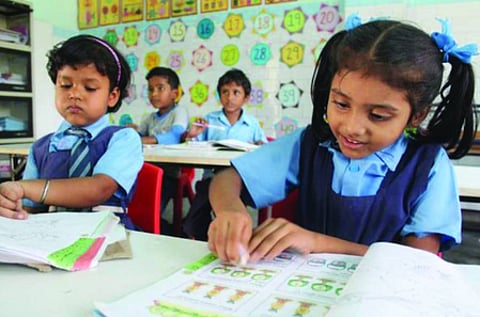
- News
- Campus
- Exam
- Podcast
- Web Stories
- Do You Know
- Path Finders - UG Programs
- Videos
- Book Review

The National Education Policy (NEP) 2020 has completed five years, and it’s been nothing short of transformative for India’s schools and universities.
As noted by India Today, NEP is touted as “a defining moment in India’s journey towards revitalising its higher education landscape”; as a policy set out to change how learning is delivered and experienced – making it more inclusive, flexible, and future-ready.
One of the most noticeable changes has been at the school level.
The old 10+2 format has been replaced with a 5+3+3+4 model, giving more emphasis on early childhood education, foundational literacy, and all-round development. Flagship initiatives like NIPUN (National Initiative for Proficiency in Reading with Understanding and Numeracy) Bharat, Vidya Pravesh, and Bal Vatikas have focused on giving young children of age 3 to 8, a strong foundation.
Learning is no longer confined to just textbooks. The curriculum is now activity-based and offered in 22 Indian languages.
Schools are becoming increasingly inclusive, with improved infrastructure and technology-enabled classrooms. Platforms like DIKSHA (Digital Infrastructure for Knowledge Sharing), which now hosts content in 133 languages, and the PM eVidya initiative have ensured access to quality learning materials through various media like TV, internet, or radio.
Technology is also being used to promote inclusion. Tools like PRASHAST are helping with early disability detection, while programmes like Vidyanjali are encouraging community participation in schools.
NEP 2020 is also shaking things up in higher education. And the aim? To move away from rigid, single-discipline colleges and push towards dynamic, globally competitive universities. The policy sets an ambitious target of reaching 50% Gross Enrolment Ratio (GER) in higher education by 2035.
Initiatives like the Vidya Lakshmi Scheme are making it easier for students to access education through collateral-free loans. Massive funding programmes such as Pradhan Mantri Uchchatar Shiksha Abhiyan (PM-USHA) and the Higher Education Financing Agency (HEFA) are aiding infrastructure upgrades and research.
Colleges are becoming more flexible, thanks to changes like the Academic Bank of Credit (ABC), multiple entry/exit options, and biannual admissions. Online education is booming too.
As per the UGC’s (Open & Distance Learning and Online Programmes) Regulations, 116 institutions now offer online/distance courses, benefitting nearly 20 lakh students.
At every level, NEP 2020 is rooted in inclusion. From setting up hostels for disadvantaged children and introducing digital learning tools for kids with disabilities, to promoting Indian languages and funding research across diverse groups, the policy aims to leave no one behind. Notably, female PhD enrollments have jumped by over 135% since 2015.
Technology has become the backbone of these reforms. Frameworks like the NCRF and National Higher Education Qualification Framework are aligning vocational and academic learning. Platforms like SWAYAM Plus and the National Apprenticeship Training Scheme are building skills for future jobs – from AI to green energy.
As India sets its sights on becoming a $35 trillion economy by 2047, research and innovation are in sharp focus. The newly created Anusandhan National Research Foundation, with a massive budget of Rs 50,000 crore, is expected to drive research output.
The results are already showing. India now ranks third globally in research publications, and patent filings have surged. Over 16,000 innovation councils have popped up across campuses, helping students and teachers turn ideas into startups and enterprises.
Indian universities are going beyond borders, too. From collaborations with foreign institutions to setting up overseas campuses, the focus is on building a strong global footprint. Indian universities are climbing higher in QS World Rankings in both university and subject categories.
The Study in India programme is expanding its global reach with a dedicated portal to attract international students to Indian campuses.
With better regulatory frameworks and accreditation systems, increased autonomy for colleges, and outcome-driven funding, NEP 2020 is quietly but steadily transforming Indian education. The system is becoming more inclusive, multidisciplinary, and future-oriented than ever before.’
